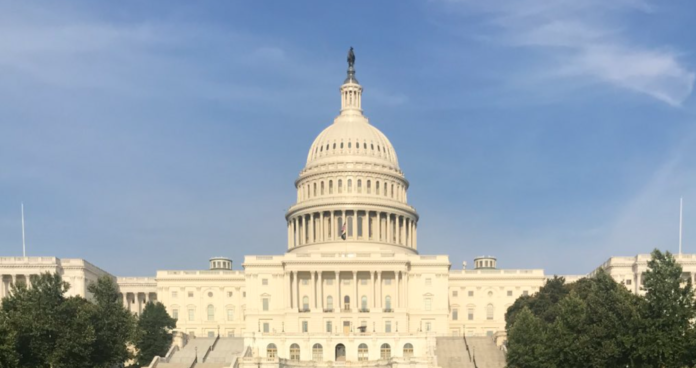Source: The Conversation (Au and NZ) – By Adrian Beaumont, Election Analyst (Psephologist) at The Conversation; and Honorary Associate, School of Mathematics and Statistics, The University of Melbourne

Shutterstock
The United States midterm elections will be held Tuesday. Owing to time differences, polls will not start closing until late Wednesday morning AEDT.
All 435 House of Representatives seats are up for election, as well as 35 of the 100 senators. Democrats won the House by 222-213 in 2020, and hold the Senate on a 50-50 tie with Vice President Kamala Harris’ casting vote.
The FiveThirtyEight forecasts now give Republicans an 83% chance to win the House and a 54% chance to win the Senate. There’s a 53% chance of Republicans winning both chambers, a 30% chance of Democrats holding the Senate while Republicans win the House, and a 16% chance of Democrats holding both chambers.
Since my October 20 article on the US midterm elections, Republicans have taken the lead in the Senate forecast after Democrats had a 61% chance to hold previously; this is Republicans’ first lead since July. Republican chances are also up in the House, from 75% to 83%.
Read more:
Republicans gain in US midterm polls with three weeks until election
Of the 35 Senate seats up for election, 21 are held by Republicans and 14 by Democrats. As Republicans are defending more seats, forecasts give Democrats a better chance to hold the Senate than the House.
The closest Senate races in the FiveThirtyEight averages are currently Georgia (tied), Pennsylvania (tied) and Nevada (Republicans up one). If Republicans won all three and there were no other upsets, they would win the Senate by 52-48. If Democrats won all three, they would win by 51-49.
Other Senate races within five points are Arizona (Democrats up two), New Hampshire (D+2), Wisconsin (R+3), North Carolina (R+4) and Ohio (R+4).
Polling of the national House popular vote now favours Republicans by 1.1% (46.6-45.5) after Democrats led by 0.3% in my October 20 article. Republicans recently regained the lead on this measure for the first time since early August.
President Joe Biden’s ratings have been steady since my last article; he’s currently at 53.1% disapprove, 42.3% approve (net -10.8). In polls of likely or registered voters, his ratings improve slightly to 53.1% disapprove, 43.5% approve (net -9.6).
In my last article on the US midterms, Democrats were already dropping in the FiveThirtyEight forecasts and poll aggregates, and this drop has continued. Republicans have made gains across the board, with Senate races that once looked safe for Democrats now close. Worries about inflation are a key reason for Republican gains.
In a Quinnipiac University national poll, conducted October 26-30 from a sample of 2,203, 36% of voters said inflation was the most urgent issue (up nine since August), with abortion well behind on 10%. By 61-34, voters disapproved of Biden’s handling of the economy, worse than his overall 53-36 disapproval rating in this poll.
At both the 2016 and 2020 elections, polls understated Donald Trump’s support. If polls are understating Republicans at these midterms, the results will be ugly for Democrats.
Poll closing times
I will focus here on the close Senate races that are within five points in the FiveThirtyEight poll aggregates. All times are Wednesday AEDT. The first US polls close at 10am in the eastern time zones of Kentucky and Indiana; Republicans will win both states easily.
Georgia will be the first state with a close Senate race to close its polls at 11am, then North Carolina and Ohio both close at 11:30am. New Hampshire and Pennsylvania will both close at 12pm. Polls in Wisconsin and Arizona will close at 1pm, with Nevada closing at 2pm. Polls in the Pacific coast states close at 3pm, with the final polls closing at 5pm in Alaska’s western time zone.
Poll closing times are derived from The Green Papers’ list, with 11 hours added to UTC/GMT.
Counting will usually take at least several hours after polls close, and in close contests we may have to wait days or even weeks for an outcome. Exit polls will be released once all polls in a state are closed, but are unreliable.
In Georgia’s Senate contest, there will be a December 6 runoff if neither major party candidate clears 50% on Tuesday. There is a third party Libertarian candidate who could prevent this.
In some states, early counting is likely to skew Republican, as Election Day votes are counted first. In other states, Democratic-leaning mail will be counted first, so their early counts will skew to Democrats.
Economic data: GDP and jobs
US GDP increased at a 2.6% annualised pace in the September quarter, after contracting in both the March and June quarters, according to the October 27 report. In Australia’s quarter on quarter terms, that’s a 0.65% increase in GDP.
The US jobs report for October was released Friday. There were 261,000 jobs created, but the unemployment rate rose 0.2% to 3.7%. The employment population ratio – the percentage of eligible Americans that are employed – dropped 0.1% to 60.0%, and is 1.2% below where it was in February 2020, before the COVID pandemic began.
Overall, this late economic data is good news for the economy, and should assist Democrats. But voters are more concerned with high inflation.
![]()
Adrian Beaumont does not work for, consult, own shares in or receive funding from any company or organisation that would benefit from this article, and has disclosed no relevant affiliations beyond their academic appointment.
– ref. With two days until US midterm elections, Republicans will probably win control of both chambers of Congress – https://theconversation.com/with-two-days-until-us-midterm-elections-republicans-will-probably-win-control-of-both-chambers-of-congress-193442









